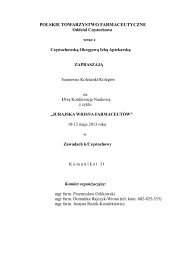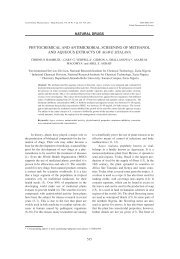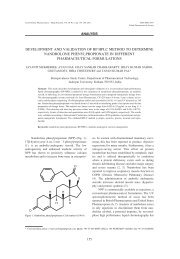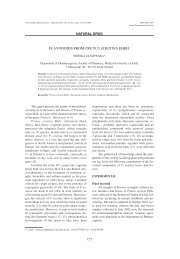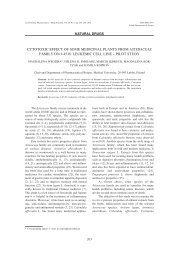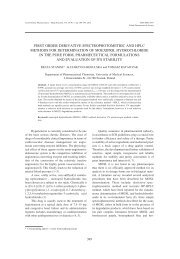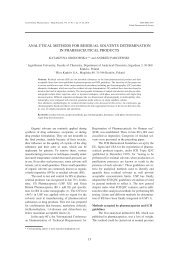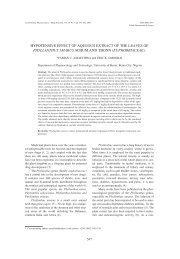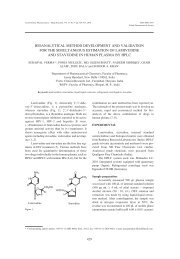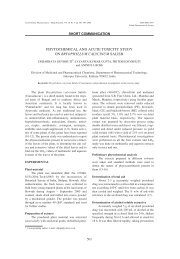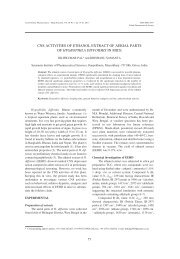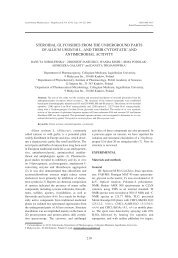pyrido-1,2-thiazines and their in vitro antibacterial evaluation
pyrido-1,2-thiazines and their in vitro antibacterial evaluation
pyrido-1,2-thiazines and their in vitro antibacterial evaluation
You also want an ePaper? Increase the reach of your titles
YUMPU automatically turns print PDFs into web optimized ePapers that Google loves.
74 WIES£AW MALINKA et al.<br />
tromyc<strong>in</strong>e was a reference drug <strong>in</strong> <strong>evaluation</strong> of<br />
compounds aga<strong>in</strong>st Staphylococcus aureus.<br />
All compounds evaluated aga<strong>in</strong>st M. fortuitum<br />
either demonstrated any <strong>in</strong>hibitory activity at the<br />
MIC 50 <strong>and</strong> MIC 90 levels, even at the maximal<br />
employed concentration (250 mg/mL), or <strong>their</strong> limited<br />
solubility prohibited an accurate determ<strong>in</strong>ation.<br />
MIC 50 for isoniazide was < 1 µg/mL, while the<br />
MIC 90 vale for this drug was greater than 250 µg/mL.<br />
However, to our complete surprise, all of the compounds<br />
tested helped to stimulate the growth of the<br />
Mycobacterium fortuitum stra<strong>in</strong> (Table 1). The best<br />
stimulant was 3d, which promoted the growth of the<br />
microorganisms > 50%, however, the maximal effect<br />
was observed only at the highest concentration used<br />
(250 µg/mL). For the rema<strong>in</strong><strong>in</strong>g compounds shown<br />
<strong>in</strong> Table 1, the maximal stimulation of growth of M.<br />
fortuitum was found with<strong>in</strong> the range of 10-50% at<br />
different concentrations for <strong>in</strong>dividual compounds<br />
(e.g. 3c ñ 15.6 µg/mL, 5b ñ 250 mg/mL). It should<br />
be noted that the replication stimulat<strong>in</strong>g effect on the<br />
microorganisms at the < 10% level was observed at<br />
sub-mg/mL concentrations (0.03-0.45 µg/mL) for<br />
most of the compounds <strong>in</strong> Table 1. The other compounds<br />
(3a,b,f,g,h, 6) tested aga<strong>in</strong>st Mycobacterium<br />
fortuitum exhibited weak stimulation (below 10%),<br />
<strong>and</strong> only after application of the preparations at the<br />
maximal concentration used (250 µg/mL, data not<br />
shown). Compounds 3-6 were also evaluated aga<strong>in</strong>st<br />
a stra<strong>in</strong> of Staphylococcus aureus (PCM 2602), however,<br />
all of them were devoid of <strong>antibacterial</strong> action<br />
at the MIC 50 as well as the MIC 90 level, even at the<br />
maximal concentration used (250 µg/mL). MIC 50/90<br />
values for erytromyc<strong>in</strong>, used as a st<strong>and</strong>ard <strong>in</strong> this test,<br />
were below 1 µg/mL. However, as <strong>in</strong> the case of M.<br />
fortuitum, the compounds enhanced the replication of<br />
S. aureus. The best stimulants of growth of these<br />
microorganisms were 3g, 4b <strong>and</strong> 3f, which enhanced<br />
replication of the bacteria at levels of 10-50% (Table<br />
1). The rema<strong>in</strong><strong>in</strong>g compounds shown at Table 1<br />
(3a,b,e, 4a) <strong>and</strong> the preparations 3c, 3d <strong>and</strong> 5b (data<br />
not shown) revealed only weak stimulation (< 10%)<br />
observed at varied concentrations for <strong>in</strong>dividual<br />
compounds [e.g. 3.9 µg/mL (4a), 250 µg/mL (3b)].<br />
The only compound which did not stimulate the<br />
growth of S. aureus was the non-enam<strong>in</strong>e <strong>pyrido</strong>-1,2-<br />
thiaz<strong>in</strong>e 6.<br />
The mechanism by which the preparations 3-5<br />
<strong>in</strong>crease the growth of M. fortuitum.<strong>and</strong> S. aureus is<br />
unclear. On the one h<strong>and</strong>, it cannot be ruled out that<br />
the bacteria are able to utilize nitrogen-conta<strong>in</strong><strong>in</strong>g<br />
fragments from the enam<strong>in</strong>e moieties of 3 <strong>and</strong> triheterocyle<br />
5b for replication. This may be partially<br />
supported by the fact that the non-enam<strong>in</strong>e <strong>pyrido</strong>-<br />
1,2-thiaz<strong>in</strong>e 6 was the only preparation which practically<br />
did not promote the growth of microorganisms.<br />
On the other h<strong>and</strong>, stimulation was also<br />
observed <strong>in</strong> the case of trihetrocycles 4 which, similar<br />
to 6, are devoid of enam<strong>in</strong>e nitrogen.<br />
It is also unclear if the <strong>in</strong>crease <strong>in</strong> bacterial<br />
replication observed at low concentration (below 1<br />
µg/mL; Table 1) is a consequence of an enhancement<br />
of bacterial growth by the compounds or <strong>their</strong><br />
lack of activity to allow on the natural growth of the<br />
microorganisms.<br />
On the basis of the above pilot data it may be<br />
concluded that modification of the β-dicarbonyl substructure<br />
of the weak antimycobacterial agents of 3-<br />
acyl-4-hydroxy<strong>pyrido</strong>-1,2-thiaz<strong>in</strong>e type II (Figure 1)<br />
does not seem to offer an <strong>antibacterial</strong> specific group.<br />
REFERENCES<br />
1. Toa Eiyo Kagaku Kogyo, pat. Jap., 8436685<br />
(1984); C.A. 101, 7177a.<br />
2. Saito K., Okutani K.: Yakugaku Zasshi, 106<br />
(1008) 1986; C.A. 107, 77727c.<br />
3. Zawisza T., Mal<strong>in</strong>ka W.: Farmaco 41, 892<br />
(1986).<br />
4. Mal<strong>in</strong>ka W., Kaczmarz M., Filipek B., Sapa J.,<br />
G≥Ûd B.: Farmaco 57, 737 (2002).<br />
5. Mal<strong>in</strong>ka W., Kaczmarz M., Redzicka A.: Acta<br />
Pol.. Pharm.Drug Res. 61, 100 (2004).<br />
6. Mal<strong>in</strong>ka W., Karczmarzyk Z., Kaczmarz M.,<br />
åwiπtek P., UrbaÒczyk-Lipkowska Z.: Pol. J.<br />
Chem. 78, 815 (2004).<br />
7. Karczmarzyk Z., Mal<strong>in</strong>ka W.: Acta Cryst. E61,<br />
1649 (2005).<br />
8. Karczmarzyk Z., Mal<strong>in</strong>ka W.: Acta Cryst. E62,<br />
5781 (2006).<br />
9. Ahmed S.A., Gogal R.M., Walsh J.E.: J.<br />
Immunol. Meth. 170, 211 (1994).<br />
10. Remau T., Sanchez J., Shapiro M., Dever J.,<br />
Gracheck S., Domagala J.: J. Med. Chem. 38,<br />
2974 (1995).



